He were an excellent man: a review of MUCH ADO at CalShakes
May 30, 2016 § Leave a Comment
As has been their pattern for the last few years, the California Shakespeare Theater (CalShakes) has opened its season with a quirky, challenging take or adaptation of a Shakespeare play. (Last year it was an almost all-female Twelfth Night.) This year it is an adaptation of Much Ado About Nothing, which greatly streamlines the play, presented by a multi-ethnic and frequently gender-switched ensemble of eight.
Directed by off-Broadway fixture Jackson Gay, who also adapted the play with Kenneth Lin, the production is successful at condensing the sprawling plot into a tightly focused hour-and-a-half. It is especially entertaining when the gender-switched central couple, Beatrice (played by James Carpenter) and Benedick (played by Stacy Ross) hold the stage.
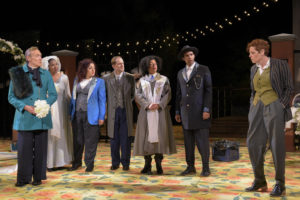
(l to r) James Carpenter as Beatrice, Safiya Fredericks as Hero, Denmo Ibrahim as Claudio, Anthony Fusco as Leonato, Rami Margron as the Friar, Lance Gardner as Don Pedro, and Stacy Ross as Benedick in California Shakespeare Theater’s production of MUCH ADO ABOUT NOTHING, directed by Jackson Gay; photo by Alessandra Mello.
Storming the Gates?
Conceptually, it is far murkier. Set, according to the advanced publicity, behind the scenes of “the biggest celebrity wedding in America,” where the catering staff acts out their pieced-together understanding of the story underneath the scandal-plagued ceremony they have just served, the adaptation succeeds best when speeding quickly past the issues of race and class it promised, in that same preview, to raise. Much Ado does not prove a very good vehicle for discussing income inequality or class privilege, largely because the original plot focuses so clearly on critiquing male privilege. Additional text by Kenneth Lin, mostly a smattering of amusingly snarky couplets, alludes to the notorious indifference of the one-percenters, but does little to further the social critique. (No rants from me against updating Shakespeare, or conceptual productions. I usually favor them. Just noting that, except in the arena of gender politics already present in the play, this particular concept did not have much to say.)
The location dictated by this concept (the untidy staging space behind a wedding venue) limited scene designer Erik Flatmo’s options. His realistic, but therefore messy, set worked well as a floorplan without giving us much to look at. The most prominent feature on the set, a second-story balcony where we are told the play’s thug, Borachio, created the illusion of seducing the confusingly named heroine, Hero, was not used for that, or really any, purpose. Of course that event is only related through exposition in the play, although it is often interpolated as a mime, but then if you are not going to stage it – echoing the issue with the overall concept – why is this feature there at all?
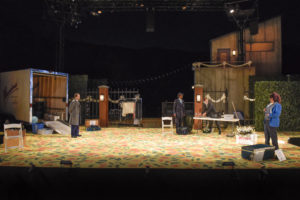
Erik Flatmo’s set for the California Shakespeare Theater’s production of MUCH ADO ABOUT NOTHING, directed by Jackson Gay; photo by Alessandra Mello.
Costume designer Karina Chavarin provides very effective pieces to be layered over the basic catering uniforms to indicate the fictional characters of the play. Visually, the heavy lifting is done by lighting designer Paul Whitaker, who not only shapes the stage with interesting compositions but helps us alternate between the framing device and the play itself with great dexterity.
Genderbending
What does work, and might have worked equally well without any added concept, is the virtuosity of the acting. The brilliant Anthony Fusco is underutilized in this production but alternates rigidly patriarchal Leonato with an “indignorant” Dogberry with speed and skill. Rami Margron, a company stalwart, is likewise used in the smallish parts of Margaret and Borachio, but single-handedly makes clear the power of cross-gender casting in the crucial but thankless role of the friar. Spoiler alert: after Hero is brutally rejected by her fiancé, her feudal lord and ultimately her father, it is the unassuming friar who steps forward to declare belief in Hero’s innocence of the charges of infidelity waged against her, and to provide the plan that ultimately resolves everything happily. In his one speaking scene, the friar explains that he knows Hero is telling the truth just by genuinely observing her reactions. Although in this production the character is still gendered male, watching a woman play the part provides a perspective on empathy that I have never experienced after seeing the role traditionally cast.
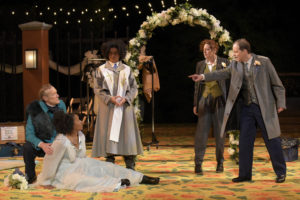
(l to r) James Carpenter as Beatrice, Safiya Fredericks as Hero, Rami Margron as the Friar, Stacy Ross as Benedick, and Anthony Fusco as Leonato in California Shakespeare Theater’s production of MUCH ADO ABOUT NOTHING, directed by Jackson Gay; photo by Alessandra Mello.
Stacy Ross gives us an original reading of Benedick through deftly handling the cross-gendering of her character so that she seems perpetually present as both the character and the underlying (female) cater-waiter presenting the story. Her intelligent interpretation of the part is informed by her gender, and we see her perspective in the way in which even she is surprised by the choices Benedick makes and the struggle to embody them.
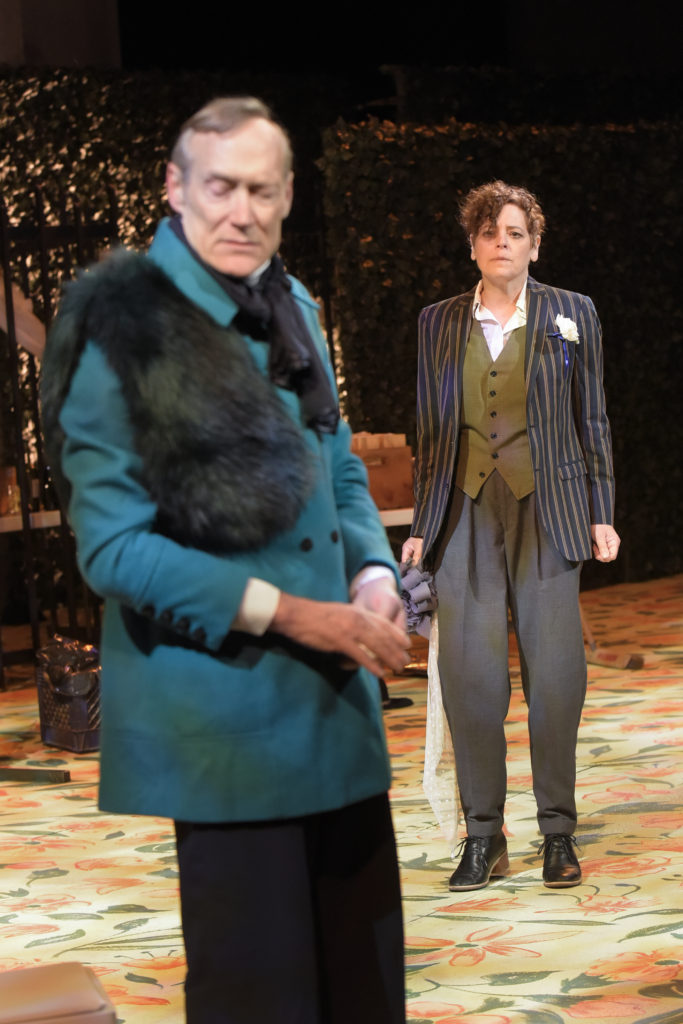
James Carpenter as Beatrice and Stacy Ross as Benedick in California Shakespeare Theater’s production of MUCH ADO ABOUT NOTHING, directed by Jackson Gay; photo by Alessandra Mello
The revelation of the night is James Carpenter in the role of Beatrice. He was seen a year ago cast perfectly to type in Pygmalion as Doolittle. It is hard to imagine someone less likely to play Beatrice, but he does it with such humanity and emotional grace that the part seems newly minted. Her pain and frustration reads as all the greater because it is clear (when situated on a male body) that they are entirely artificial limitations placed on her.
The versatile cast is rounded out by Patrick Alparone, Safiya Fredericks, Lance Gardner, and Denmo Ibrahim.
CalShakes is the big dog among Bay Area Shakespeare festivals. It has consistently high production values and standards. It is situated in the very diverse East Bay and has a great track record of developing and serving a contemporary audience. Much Ado does not quite deliver on its potential to comment on social disparity just down the freeway, but it is still a worthwhile night in the theatre–especially recommended for those who know the play well and are ready to see the traditional comedic war-of-the-sexes battle lines redrawn.
PS: CalShakes has a new artistic director, Eric Ting, who welcomed the audience warmly for this opening night but it will be later in the season, when he makes his directorial debut with Othello, before we get a full sense of what he will bring to the company.
Details:
California Shakespeare Theater’s production of Much Ado About Nothing by William Shakespeare, adapted by Kenneth Lin and Jackson Gay, with additional text by Kenneth Lin.
Directed by Jackson Gay. Designed by Eric Flatmo (set designer), Karina Chavarin (costume designer), Paul Whitaker (lighting designer), and Olive Mitra (sound designer/composer).
May 25–June 19, 2016
(Tuesdays through Thursdays at 7:30pm, Fridays and Saturdays at 8pm, Saturday Matinee June 18 at 2pm
Sunday Matinees at 4pm)
Bruns Amphitheater, 100 California Shakespeare Theater Way, Orinda, CA 94563
Why Verse?
June 17, 2013 § 1 Comment
Why does Shakespeare use verse so extensively in his plays? Why, in fact, do almost all playwrights before the twentieth century?
The conventional wisdom, which I think is wrong, is that verse is the best medium for aesthetically beautiful speaking and/or that it is easier to memorize. Both seem theatrically unlikely explanations to me.
Speaking “beautifully” was not widely admired, or even possible, until after the advent of dimmed indoor lighting in the nineteenth century, which hushed audiences for the first time. Before then, it was powerful voices that could make themselves heard over the crowd and command its attention that were admired. Verse does not help that.
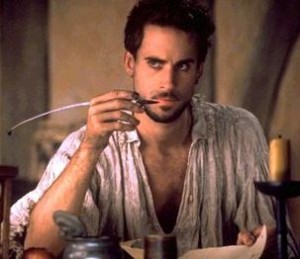 Joseph Fiennes in Shakespeare in Love
Joseph Fiennes in Shakespeare in Love
Verse is somewhat easier to memorize but not enough to justify the substantial effort it takes for the playwright to create it. Besides, the convenience of the actors has never been a noticeable consideration in the construction of plays.
Verse does accomplish something theatrically useful, but because we now live in a visual culture, it seems counter-intuitive. Verse is actually easier to hear and understand. In addition to content clues, we also get clues about what is being said from rhythm and (when it occurs) rhyme. In an oral/aural culture, greater communicative power is an advantage worth the trouble that versification requires.
Joss Whedon’s new film version of Much Ado About Nothing, which I reviewed at greater length in a previous post, got me thinking about this again. The performances in it are stripped of all conventions regarding “beautiful” Shakespeare, but there is a ferocious intensity around conveying the narrative. See it, or should I say listen to it, if you want to hear what verse is for.
Performing MUCH ADO, Without So Much Performing
June 14, 2013 § Leave a Comment
If you sit through even one round of amateur auditions for a Shakespeare play, you will quickly learn that Americans have an almost reflexive assumption that the “right” way to perform the Bard is not only in the King’s English but in high rhetorical style as well. Why would they not? Almost all Shakespeare to which they are exposed on big or little screens confirms this image. It does not matter that their teachers tell them Shakespeare didn’t sound that way, (you can hear what he did sound like in this YouTube), or that the acting style they are imitating was developed for the two-thousand+ seats of auditoriums in another era, when pop culture instructs them otherwise.
Now, however, the cast of Joss Whedon’s Much Ado About Nothing gives the most unaffected performance of a Shakespeare play ever put on film. For those of fascinated by such issues, the success of this new release might finally reorient the suppositions about the stylistically “correct” conventions for performing Shakespeare.
 Elsa Guillet-Chapuis
Elsa Guillet-Chapuis
Whedon’s take on this early comedy is a modern-dress production filmed in his Santa Barbara home over a two-week break in post-production for The Avengers. For a version of the play so aggressively reset visually, it is a remarkably faithful rendering of the play. Far from being an adaptation “based” on Shakespeare, the script is cut lightly and its content almost completely unchanged.* That is, the performance style is not achieved by wholesale rewriting Shakespeare, a lá 10 Things I Hate About You or She’s the Man.
Given the direct simplicity of the performance style, how do they handle the language? For the most part, exceedingly well, but without any displays of technique or stage mannerisms that telegraph the complexity of what they are doing. Compared to Kenneth Branaugh’s delightful, but veddy Britished-up, film of the same play, it is thoroughly American and remarkably understated. No British accents, no grand old men of the English theatre in cameos, and most of all no “beautiful speaking.”
At the core of the film is Amy Acker’s astonishing performance as Beatrice. She delivers an emotionally honest and vulnerable performance as Benedick’s once and future love. While climbing to comic heights for Beatrice’s farcical reaction after overhearing gossip of Benedick’s supposed infatuation with her, (“What fire is in mine ears? Can this be true?”), her performance largely relies on darker notes. Her sense of humor is defensively brittle from the outset. Later, her fierce anger at the betrayal of her cousin, and her confrontations with men responsible (including Hero’s own father), are delivered without any softening concession to humor at all.
Alexis Denisof gives us a less emotionally complicated Benedick, but to the degree that his performance is relying on precedents it is inspired by screwball comedies and not Shakespearean theatrics. For example, he willingly throws away Benedick’s famous kicker that he will allow God to choose his wife’s hair color after a long list of “must have” perfections he imposes. Winking and nudging are unnecessary, however, after completing the entire monologue while running stair laps in his sweat clothes. We already understand Benedick’s vanity. Denisof has taken some critical heat for not matching Acker’s depth, most of it completely overlooking that the subject of Much Ado is male immaturity.
Fran Kranz as the callow Claudio makes much of the young man’s overconsumption of alcohol early in the film as explanation for his character’s adolescent fit of jealousy toward Don Pedro, whose wooing of Hero on his behalf he mistakes for (to use a term he might well employ) “cockblocking.” Claudio’s later rejection of Hero is not intended to be sympathetic, but in this case it is thoroughly believable – even in a modern context – because Kranz has already shown us the young man’s insecurity. He gets Claudio’s teary repentance at the end so right, with such honesty, that the bizarreness of the words he is given to express it passes unnoticed.
Jillian Morgese does not quite keep pace as the spurned love interest, Hero, but she does not drown the role in clichéd signifiers of girlishness either, as is common. (Whedon’s great directorial touch was allowing the character to watch Claudio’s rite of penitence. Her seeing Claudio’s atonement goes a long way to justifying her reconciliation with him in the end, which is often a mystery in itself.)
The revelation in this film is Nathan Fillion’s Dogberry. If you have Michael Keaton’s interpretation in mind from the Branaugh version, then you might think of this as a character straight out of Monty Python which can only be saved with laying it on as thick as possible. Fillion goes the opposite route. He plays, indeed underplays, the role straight. He delivers the relentless stream of malapropism without a single indication they might be jokes, which is what makes them hilarious. Once Conrad has called him an “ass,” he fixates on that insult with the genuine pain of a man who cannot let a slight go. For once the humor seems organic and not pasted on.
In sum, the entire cast performs this script as if it was fresh from the writer’s room. They deliver it with amazing reverence for the words and images, but stylistically they act like their jobs are not to perform Shakespeare the way you “perform” Shakespeare, but the way you act for the camera. The conventional wisdom is that successful film actors are those who affect a complete lack of affectation the best, but however artificial that style is in its own way, it works wonders to freshen Shakespeare here. In this case, it erases all the condescension and all the cultural imperialism with which Shakespeare is usually loaded and lets us concentrate on the narrative.**
Nowhere in the film is this as highlighted as it is in what is traditionally known as the “Chapel Scene.” Benedick impatiently chooses the evening after Claudio’s ruthless rejection of Hero at the altar as the time to declare his love for Beatrice. She, in turn, uses the moment to enlist a champion to challenge Claudio and stand up to the complicit Don Pedro. The scene contains the most notoriously difficult line in the play. When Benedick asks Beatrice to name any task by which he might prove his love she answers simply, but with about five levels of complexity, “Kill Claudio.” Frequently, this line gets a “bad laugh” and the play slips away. In Acker and Denisof’s hands, it plays like something out of their old partnership on Angel. It is hard to believe that Whedon did not add the scene. It seems so Whedonesque. Perhaps Shakespeare can still be out contemporary.
*The average stage production of Much Ado is far more edited than Whedon’s version. The only substantial changes introduced are one piece of genderblind casting, rewording of Benedick’s anti-Semitic quip, and the placing of Hero at her own memorial service. Surprisingly, Claudio’s casually racist remark is retained with the usual cringing taking place onscreen instead of in the audience – to hilarious effect.
**For a dissenting view, see Jason Michelich’s review for Wired, which proposes the whole point of film is to get over narrative and get on with auteurs creating as much aut as possible, a lá Terrence Malick.